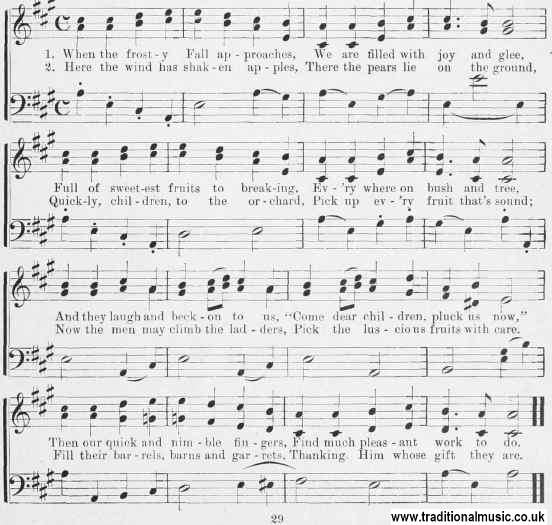Songs Games And Rhymes
For The Nursery, Kindergarten & Primary School
More that 200 songs with lyrics & Sheet music
| Share page | Visit Us On FB |
|
[Note to "Autumn Leaves:"—Two or three children in a distant part of the room represent "lambs." One child in another part of the room is the " cricket." A long string of beads, in some suitable location near by, is the "brook." The kindergartner (or some larger child) represents the "north-wind." The remaining children are the "leaves." The "north-wind" and the "leaves" form the ring.
At " Come little leaves," the "leaves" raise their arms as if still hanging from the branches of a tree, and keep up a fluttering movement with their fingers. At "put on your dresses," they take their skirts lightly in their fingers and make a little bow; at "winter is coming," they look at the '"'north-wind" and shiver, and immediately start to run merrily from place to place, pursued by the whistling, blowing " north-wind." When the close of the stanza has been reached, the ring is formed quickly without interrupting the singing. This merry chase is repeated at the close of every stanza, except the fifth, during the singing of the refrain, " Winter is coming, etc."
During the singing of the second stanza, the lingers again represent the fluttering movements of leaves as before, until the refrain is reached.
At the third stanza all join hands and go to the "cricket," who accompanies the stanza with a few musical "chirrups." At " Little brook," the}" pass over to the "brook" and hover near it during the remaining lines.
At the fourth stanza all join hands and surround the bleating " lambs." At the opening of (he fifth stanza all dance (or whirl) about very lightly; at " soon fast asleep," they kneel close together near the center of the ring, heads bowed and eyes closed, while the kindergartner spreads over them a large piece of white netting to imitate the snow.
After a few moments of silence, the kindergartner sings the last stanza of Little Jack Front (see Xo. 40), " But when Dame Nature, etc.," the " cricket" begins to chirrup, the " lambs " begin to bleat lustily, and the children under the netting—now representing flowers—open their eyes, form buds with their hands, slowly rise, and take their places in the ring.]
37. Autumn Song.
Fr. Seidel, Transl. bv W. K. H. Beethoven. |
||
 |
||